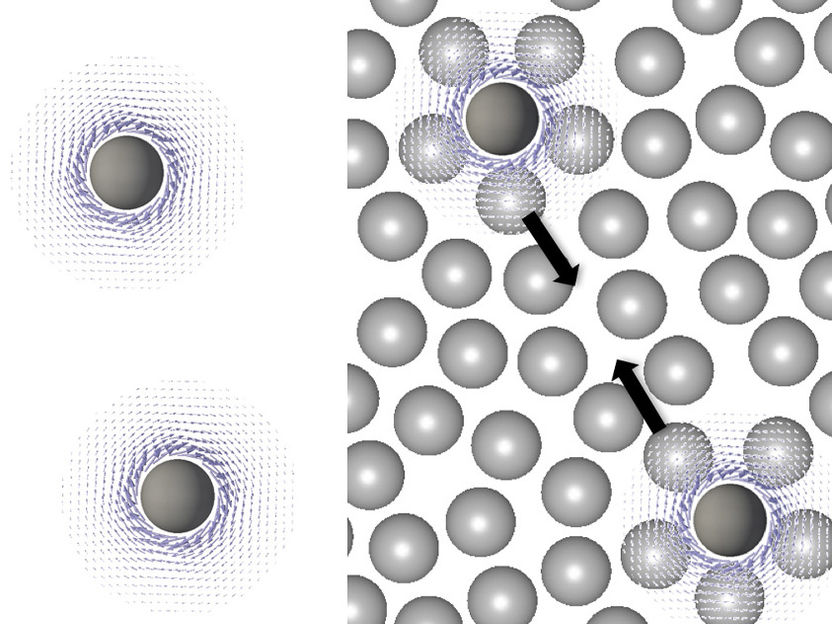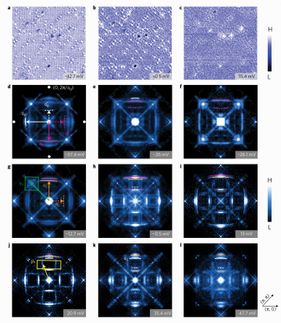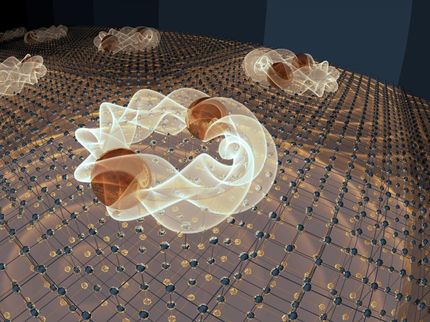Study finds unexpected long-range particle interactions
Spinning cells could attract each other across surprisingly long distances.
Moving bodies can be attracted to each other, even when they're quite far apart and separated by many other objects: That, in a nutshell, is the somewhat unexpected finding by a team of researchers at MIT.

Researchers have found a new kind of long-range interaction between particles, in a liquid medium, that is based entirely on their motion. Alfredo Alexander-Katz describes the kind of interactions his team found as being related to the research field of active matter. Example of active systems are the flocking behavior of birds or the schooling of fish. In this illustration, moving particles in a liquid medium (left) are not attracted, but when they are surrounding by non-moving particles (right) they are gradually pulled together.
Alfredo Alexander-Katz/MIT
Scientists have known for a long time that small particles of matter, from the size of dust to sand grains, can exert influences on each other through electrical, magnetic, or chemical effects. Now, this team has found a new kind of long-range interaction between particles, in a liquid medium, that is based entirely on their motions. And these interactions should apply to any kind of particles that move, whether they be living cells or metal particles whirled by magnetic fields.
The discovery, which holds for both living and nonliving particles, is described in a paper by Alfredo Alexander-Katz, the Walter Henry Gale Associate Professor of Materials Science and Engineering at MIT, and his co-researchers, in the Proceedings of the National Academies of Sciences.
Alexander-Katz describes the kind of interactions his team found as being related to the research field of active matter. Example of active systems are the flocking behavior of birds or the schooling of fish. Each individual member of the system may be responding just to others in its vicinity, but the result is a coherent overall pattern of movement that can span a large region. Cells in a fluid medium, or even tiny structures moving within a cell, exhibit similar kinds of motion, he says.
The researchers studied magnetic particles a few micrometers (millionths of a meter) across, comparable to the size of some cells. A small number of these magnetic metal microparticles were interspersed with a much larger quantity of inert particles of comparable size, all suspended in water. When a rotating magnetic field was applied, the metal particles would begin to spin, simulating the movements of living cells in the midst of nonliving or relatively inert objects -- such as when cells migrate through tissues or move in a crowded environment.
They found that the spinning particles, even when separated by distances tens of times their size, would ultimately migrate toward each other. Though that attraction progressed through a slow and apparently random series of motions, the particles would in the end almost always come together.
While there has been a lot of research on interactions among active particles, Alexander-Katz says, this is one of the few studies that has looked at the way such particles interact when they are surrounded by inactive particles. "In the absence of the inactive particles there are essentially no interactions," he says.
The unexpected finding might ultimately lead to a better understanding of the behavior of some natural biological systems or new methods for creating synthetic active materials which could be useful for selectively delivering drugs into certain parts of the body, Alexander-Katz suggests. It could also end up finding applications in electronics or energy-harvesting systems, for example providing a way to flip a crystal structure between two different configurations.
"What we're addressing is collective excitations of the system, or coherent excitations," he explains. "What we're looking at is, what are the interactions as a function of activity" of the individual particles.
The faster the particles spin, the greater the attraction between them, the team found. Below a certain speed the effect stops altogether. But the amount of inert matter also makes a difference, they found.
With no inert particles -- if the moving particles are suspended in clear water -- there is no motion-based attraction. But when the nonspinning particles are added and their concentration reaches a certain point, "there is attraction!" Alexander-Katz says.
One unexpected aspect of the findings was how far the effect extended. "What was really surprising was that the range of the interactions is gigantic," he says. By way of comparison, he says, imagine you're in a crowd, and you start to move a bit, and someone else also starts to move, while everyone else tries to stand still. "I would be able to sense, even 20 people away or more, that that person is also active -- assuming that the other folks around us are not active."
The attraction, he says, "is not chemical, it is not magnetic, it is not electrostatic, it's just based on activity." And because the range is so long, these interactions could not be modeled in simulations but required physical experiments to be uncovered. The tests by Alexander-Katz and his team used two-dimensional films, similar to particle sediments that form on a rock surface, he says.
He speculates that some biological organisms may use this phenomenon as a way of sensing parts of their environment, though this has not yet been tested.





















































